 After the great shock exerted by the COVID-19 pandemic on the global economy, as well as on world trade, 2021 fortunately marked the beginning of a path to recovery.
After the great shock exerted by the COVID-19 pandemic on the global economy, as well as on world trade, 2021 fortunately marked the beginning of a path to recovery.
International trade data on consumer goods prove the start of a phase of a rebound, after the deep drop experienced in 2020, close to -5%. According to ExportPlanning data, available on MarketResearch.com, global consumer goods exports more than recovered their pre-COVID-19 levels in 2021, growing by almost 14% in quantity last year — and by more than 8% if compared to 2019.
Nonetheless, the analysis of the specific sectors of the consumer goods industry reveals differentiated performances: while household products and pharmaceuticals show significant growth rates in 2021, compared to 2019, packaged food and beverage appear quite stable. On the contrary, consumer packaged goods and the fashion area are slightly lagging behind.

Pharmaceuticals and Medical Products on a Solid Growth Trend
Starting from the best performers, the sector of pharmaceuticals and medical products inevitably shows the most dynamic growth trend among consumer goods, when comparing 2021 with 2019 (pre-pandemic base year). World trade data reveal double-digit increases for almost all the major pharma sub-sectors, during a new historic phase of emergency that puts health centre stage.
In particular, levels reached in 2021 appear far higher than pre-pandemic ones for drugs and medicaments (+29% at constant prices, compared to 2019), as well as medical and dental instruments and equipment (+18%).

Household Products Benefit from New Habits
As for household products, during the pandemic year world trade proved quite resilient, while in 2021 it embarked on a favourable growth dynamics: global demand for household products increased in quantity by almost 15%, compared to 2020.
Against this backdrop, virtually all sub-sectors were able to show higher levels of world exports than in 2019. Trade flows of pots and pans proved as the most dynamic (+34% at constant prices, compared to 2019), followed by chandeliers and lighting fixtures, home appliances and home textiles, which increased by about 20%. Data reveal significant growth rates for consumer electronics and furniture as well, which increased by about 10% in 2021, compared to 2019.
The general economic situation thus appears quite favourable for the whole household sector, which seems to benefit from a renewed interest in home care among international consumers.
Packaged Food and Beverage Show Stability
In the sector of packaged food and beverage, the 2021 performance of global exports was generally subdued, showing stability with respect to 2019. Oil, condiments and spices ranked as best performers (+9% at constant prices, compared to 2019), as well as cookies and other baked goods (+7%); modest increase for rice, pasta and flour, as well as tea and coffee, vegetables and fruit, and milk, yoghurt, butter and cheese.
Sectors showing lower trade flows than pre-pandemic ones include alcoholic beverages (-5.3% at constant prices, compared to 2019) and water and soft drinks (-4.3%), both of which were undoubtedly impacted by lower out-of-home consumption as a result of the pandemic.

Consumer Packaged Goods & Fashion Still Lagging Behind
Not all branches of the consumer goods industry showed a full recovery. As previously mentioned, in 2021 world trade of consumer packaged goods appeared to be still lagging slightly behind its pre-COVID levels, in spite of a diverse performance among the different sub-sectors. On the one hand, global demand for pet food showed a confirmation of its positive trend started in 2020: world trade of pet food increased by more than 20% in 2021, compared to 2019 pre-pandemic levels. On the other hand, products such as cigarettes fell by more than 15% in 2021, compared to 2019, while personal care products decreased by over 3%.
As for fashion and personal products, global demand showed a strong rebound in 2021, which however did not completely fill the gap with pre-COVID levels: all in all, the sector remains more than 2 percentage points below its pre-pandemic figures.
In this cluster, sporting goods and musical instruments showed the strongest growth in 2021, with respect to 2019 levels (more than +40%). Another leisure-related sector showing a decidedly positive dynamics refers to bicycles, whose trade flows grew by more than 20% in 2021, compared to 2019. However, some sub-sectors are still far from pre-pandemic levels in term of global trade data: this is the case for footwear (-15% in 2021, compared to 2019), bags and suitcases (-14%), as well as perfumes and cosmetics (-6%).
Keep Up to Date with the Latest Global Trade Trends
Need access to more international trade data? On MarketResearch.com, you can find a wide variety of ExportPlanning reports that can help you navigate foreign markets and their latest developments.
Some examples include:
Packaged Food & Beverage:
Fashion and Personal Products:
Household Products:
About ExportPlanning
ExportPlanning provides two kinds of reports to stay up to date with international trade trends and support the choice of promising target markets. Market Research Reports offer a broad overview of market trends (past, current, and expected) for all the relevant markets, as well as the positioning of the main competitor countries, for a specific business unit (product, sector, or industry). Market Barometer Reports help you to stay up to date with the latest trade trends, on a quarterly basis. The reports make extensive use of data visualization to help the user grasp ideas and concepts quickly and effectively.

